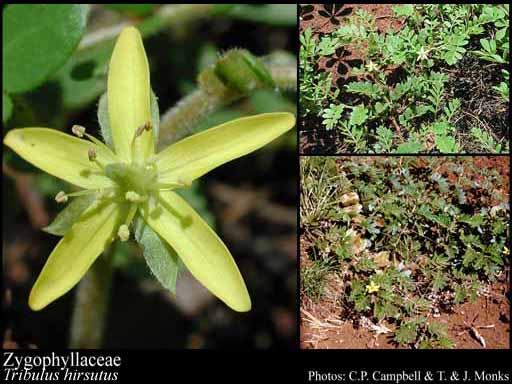- Reference
- Voy.Terra Austral. 2:545 (1814)
- Name Status
- Current

Scientific Description
Common name. Caltrop Family.
Habit and leaf form. Trees, or shrubs (mostly), or herbs (often with jointed nodes); resinous (often), or not resinous. Plants succulent, or non-succulent. Perennial. Xerophytic (and often halophytic, in salt-deserts). Leaves opposite (usually), or alternate; when alternate, spiral; ‘herbaceous’, or leathery, or fleshy, or modified into spines; non-sheathing; compound; unifoliolate, or bifoliolate, or ternate, or pinnate. Leaf blades pinnately veined; cross-venulate. Leaves with stipules. Stipules free of one another; often spiny; persistent. Leaves without a persistent basal meristem. Stem anatomy. Nodes tri-lacunar. Secondary thickening developing from a conventional cambial ring, or anomalous.
Reproductive type, pollination. Fertile flowers hermaphrodite. Unisexual flowers absent. Plants hermaphrodite. Entomophilous.
Inflorescence and flower features. Flowers solitary, or aggregated in ‘inflorescences’. The terminal inflorescence unit cymose. Inflorescences terminal, or axillary, or leaf-opposed. Flowers ebracteate; ebracteolate; regular; (4–)5(–6) merous; cyclic; tetracyclic, or pentacyclic, or polycyclic. Floral receptacle developing a gynophore, or with neither androphore nor gynophore. Free hypanthium absent. Hypogynous disk present (usually), or absent. Perianth with distinct calyx and corolla (usually), or sepaline (the corolla sometimes lacking); (4–)5, or (8–)10(–12); (1–)2 -whorled; isomerous; without spots, or spotted. Calyx (4–)5(–6); 1 -whorled; polysepalous, or gamosepalous; imbricate (usually), or valvate; regular. Corolla when present, (4–)5(–6); 1 -whorled; polypetalous; imbricate, or contorted, or valvate (rarely); regular; white, or yellow, or red, or blue (rarely). Androecium (4–)5, or 10, or 15. Androecial members free of the perianth; free of one another; 1–3 -whorled. Androecium exclusively of fertile stamens, or including staminodes (the episepalous whorl sometimes sterile). Staminodes when present, 4, or 5. Stamens (4–)5, or 10, or 15; isomerous with the perianth, or diplostemonous, or triplostemonous; alternisepalous, or oppositisepalous (when the outer whorl sterile). Filaments appendiculate (commonly, with basal ligular scales which may unite to form an appendage within the staminal ring), or not appendiculate. Anthers dorsifixed; versatile; dehiscing via longitudinal slits; introrse, or latrorse; tetrasporangiate. Gynoecium (2–)5(–6) carpelled. The pistil (2–)5–12 celled. Carpels isomerous with the perianth (usually), or reduced in number relative to the perianth, or increased in number relative to the perianth. Gynoecium syncarpous; eu-syncarpous; superior. Ovary plurilocular; (2–)5(–6) locular (usually), or 5–12 locular (via secondary septa, in Tribulus). Locules secondarily divided by ‘false septa’ (Tribulus), or without ‘false septa’. Gynoecium non-stylate, or stylate. Styles 1; attenuate from the ovary; apical. Stigmas 1; lobed or capitate; wet type, or dry type; papillate; Group II type, or Group III type. Placentation axile. Ovules 1–50 per locule (to ‘several’ or to ‘many’); pendulous; apotropous; with ventral raphe; non-arillate; anatropous (usually), or hemianatropous, or orthotropous, or campylotropous.
Fruit and seed features. Fruit non-fleshy (usually), or fleshy; dehiscent (usually), or indehiscent, or a schizocarp. Mericarps when schizocarpic, comprising nutlets (‘indehiscent cocci’). Fruit when non-schizocarpic a capsule (usually), or a berry, or a drupe. Capsules septicidal, or loculicidal, or septicidal and loculicidal. Fruit elastically dehiscent (when of cocci), or passively dehiscent. Seeds endospermic, or non-endospermic. Endosperm oily. Cotyledons 2. Embryo chlorophyllous (3/3); straight, or curved. Seedling. Germination phanerocotylar, or cryptocotylar.
Physiology, biochemistry. Mustard-oils present. Aluminium accumulation not found. Photosynthetic pathway: C3 and C4.
Geography, cytology, number of species. World distribution: widespread tropical, subtropical and warm temperate, often in drier areas. X = 6, 8–13(+). 240 species.
Economic uses, etc. Guaiacum officinale is the source of the hardest, densest wood (lignum vitae). Guaiacum, Zygophyllum, Tribulus and Larrea species are cultivated in warm regions as ornamentals.